Cut Grade in a Diamond Certificate – What You Need to Know
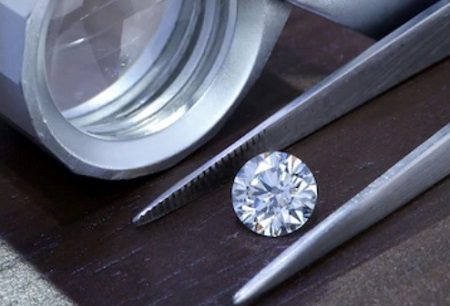
Cut is the most complex and technically difficult factor to analyze.
Contrary to common belief, cut does not refer to shape of the diamond (i.e. oval, pear or round). Instead, a diamond’s cut grade is an assessment of how well it interacts with light and is comprised of factors like polish, symmetry and proportions.
Out of the 4Cs, Cut is arguably the most important C as it has the most significant bearing on a diamond’s physical appearance.
A well cut diamond will exhibit a great balance of these attributes and look breathtaking. In contrast, a poorly cut diamond will resemble frozen spit and look dull. This is why I always emphasize the importance of getting the best cut possible when you are selecting a diamond.
In today’s market, there are many gemological labs that provide diamond grading services for the industry. However, each lab has a slightly different way of representing the cut grade in a report.
To help you understand things better, we are going to explain how cut is represented by 4 of the most well-known labs and take a look at their respective grading reports.
How Are Diamonds Graded For Cut Quality in the Laboratory?
When a gemological lab like GIA evaluates a round diamond for its cut quality, they assess the diamond’s proportions and inspect the diamond visually for its fire, brilliance and scintillation (contrast patterning). Here’s a quick explanation of what the terms mean:
Brightness: Brilliance that results from a combination of white light reflections from the diamond’s internal and external surfaces.
Fire: The way light is dispersed into various colors of the spectrum. It is typically seen as rainbow color flashes and found predominantly in the crown facets area.
Scintillation: Scintillation refers to the sparkle patterning a diamond displays when it is moved or tilted at an angle to the eye (shades of light and dark).
GIA – The World’s Foremost Authority in Gem Grading
GIA Diamond Grading Report – From January 2006, GIA started to include the cut grading of round brilliants in their reports. This cut grade (on a scale of excellent to poor) is assigned based on a combined assessment of the diamond’s proportions, polish and symmetry.
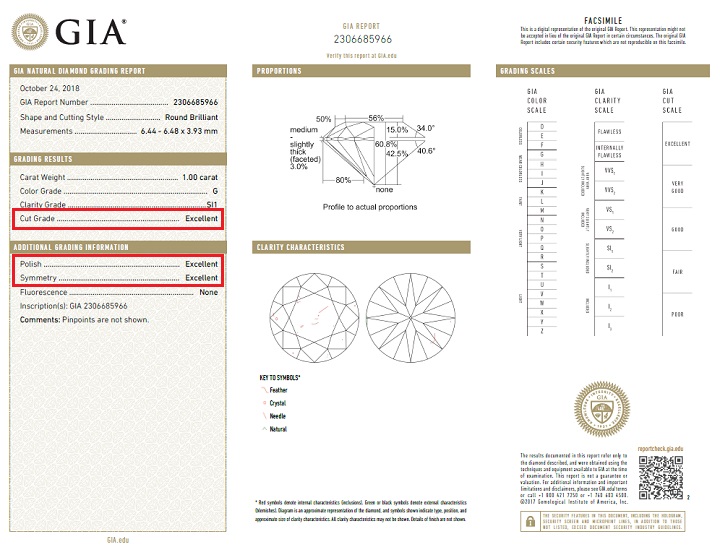
The full GIA diamond grading report with a clarity plot of inclusions.
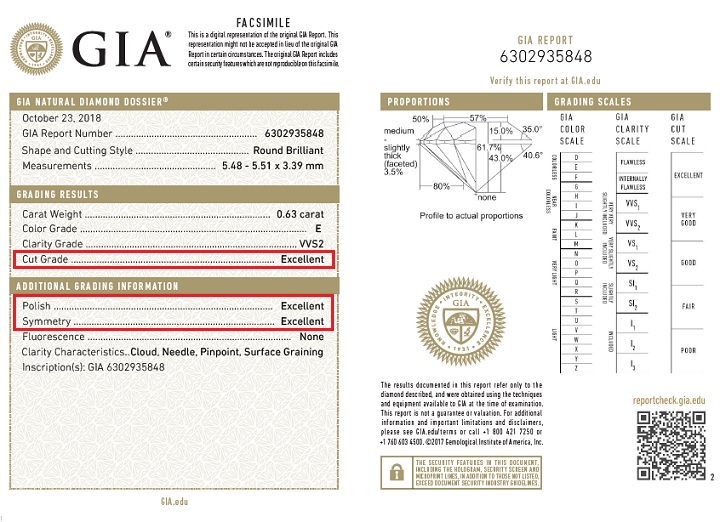
The GIA Dossier report is typically used for diamonds less than 1 carat in size.
American Gem Society – Taking Cut Grading to a Higher Level
AGS Diamond Quality Document – AGS was the first independent grading organization to utilize a numerical system in their reports – with 0 being the highest grade. As a diamond deviates further from having ideal light performance, so does the numerical grading value as it starts increasing from 1(Excellent), 2 (Very Good), through to 10 (Poor).
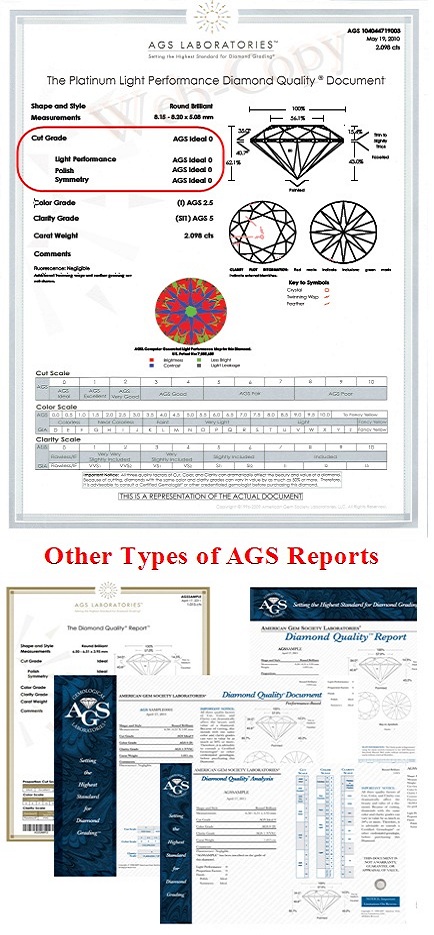
In the AGS report, the following aspects of a diamond’s cut are evaluated: Crown and Pavilion Angle, Pavilion Depth, Girdle Thickness, Table Diameter, Polish, Culet size, Performance, and Symmetry.
Compared to other labs, the AGS cut grading system follows a more scientific approach which provides better objectivity when assessing a diamond’s cut grade. More notably, they subject the diamond to a comprehensive ray tracing analysis and also evaluate the diamond’s light return with the ASET.
International Gemological Institute – Popular in Europe And Asia
IGI Diamond Report – This report contains similar information found in a GIA report but doesn’t include a proportions diagram. The IGI report provides proportion measurements of the diamond in a numerical format and assigns cut grades within a range of Ideal, Excellent, Very Good, Good and Fair.
The five criteria that IGI primarily use for grading a diamond’s cut are: Total Depth, Girdle Thickness, Pavilion Depth, Crown Angle, and Table Width.
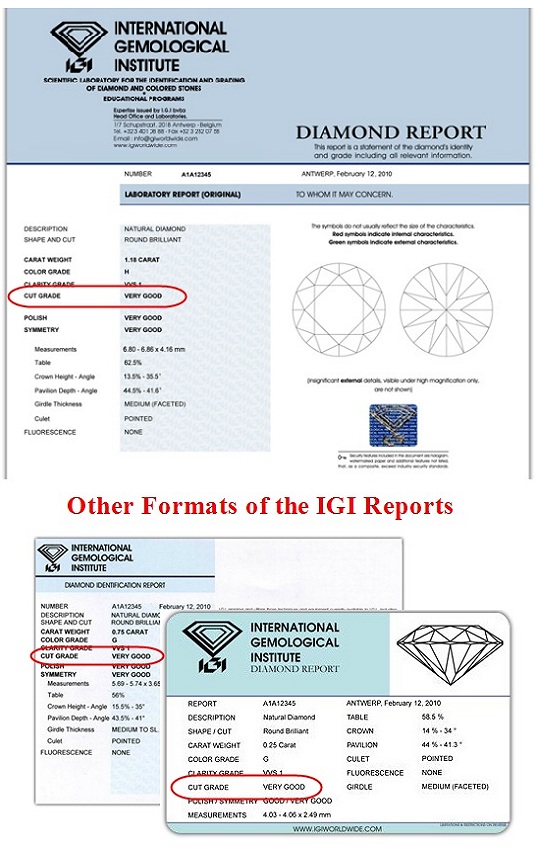
Note: IGI grading reports can come in various formats depending on the request.
European Gemological Laboratory – The Jeweler’s Marketing Tool
EGL Report – If you are a consumer intending to make a purchase, stay away from diamonds graded by EGL. EGL is notoriously known for their leniency and lax grading standards.
If you had done some research, you probably found that EGL diamonds are usually priced lower than diamonds graded by other labs like GIA and AGS. However, this does not mean you are getting a good deal.
The truth is, the lower price is reflective of the lower quality diamond it really is. When looking at an EGL report, you can expect to discount 2-3 grades in the diamond’s color and clarity instead of taking the EGL report at face-value.
I don’t recommend buying diamonds with EGL reports as they are often used by unethical jewelers to rip consumers off.
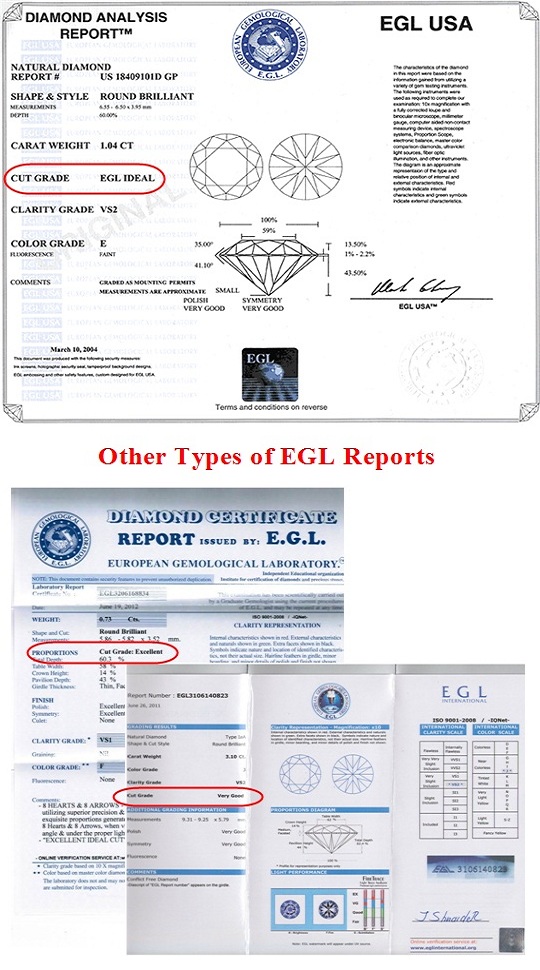
For round brilliants, EGL USA offers the Diamond Analysis Report and issues cut grades within the range of: Ideal Plus – Ideal – Very Good – Good – Fair.
The Ugly Truth – 90% of the World’s Diamonds Are Poorly Cut
When a cutter is fashioning a diamond from a rough stone, he endeavors to strike a balance between “optimal” cut (which eventually determines appearance) and maximum yield (preserving carat weight from rough stone).
However, the fact that people are willing to pay more for a bigger poorly cut diamond than a smaller well cut diamond puts a lot of pressure on the cutter to preserve weight from the rough stone. Since the value of a diamond is directly proportional to its weight, cut quality is usually compromised for carat weight.
This is the reason why the majority of diamonds are often cut to poor proportions. It is also why you often see diamonds with precise carat weights at 0.70 or 1.00 carat instead of 0.67 or 0.96 since they sell for more!
Should You Buy Based Solely on What the Report Says?
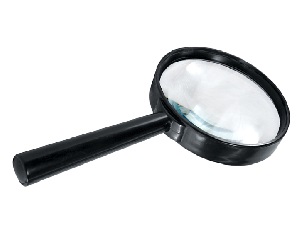 At this point, I want to go on the record saying that you should only consider buying diamonds graded by GIA or AGS. They are the most consistent labs in terms of their grading standards and offers assurance that the diamond’s qualities have been accurately described.
At this point, I want to go on the record saying that you should only consider buying diamonds graded by GIA or AGS. They are the most consistent labs in terms of their grading standards and offers assurance that the diamond’s qualities have been accurately described.
Next, bear in mind that a diamond’s cut grade is a key factor for consideration when you are making selections. Also, you should note that the lab report isn’t an end all be all solution for selecting the best possible stone.
You see, the grading labs allow diamonds within a range of proportions to fall within their top tier cut category. However, just because a diamond’s proportions fall within “ideal” ranges, it doesn’t mean that the facets interact together as a whole to give the stone optimal light performance.
In order to help you determine this, the easiest method is to use light performance scopes like the ASET and Idealscope for assessment. To find out more, we had dedicated an entire section of the website showing you how to pick a diamond here.
Lastly, I want to share an interesting story with you before I end this article. In a recent trade show I attended, I had the opportunity to speak to people in the management levels from various labs such as EGL, GIA and AGS. I asked them the following question. “Would you buy a diamond graded by your own lab based on a certificate alone assuming that it has the best possible ratings in all aspects of cut?”
The answers were all unanimously: No. Mind you, these are all expert graders in the field and not some unknown John Doe. All of them stated that they either need to look at the diamond in person or require further data before they would commit to a purchase.
The moral of the story here is – you do require additional data beyond a grading report if you want to make rational buying decisions!
Magnified images, video and analytical cut data are provided in White Flash listings.
Related Articles
Leave A Comment

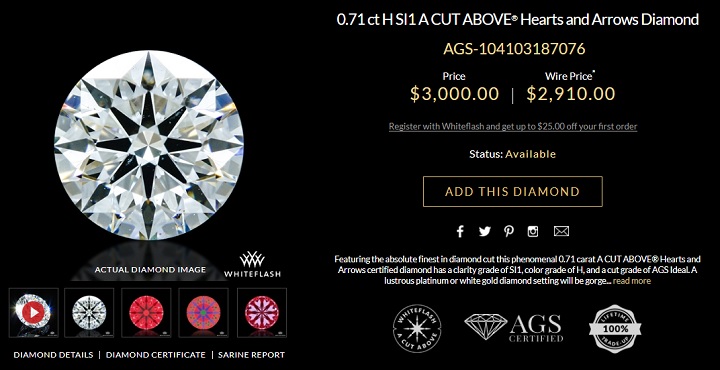

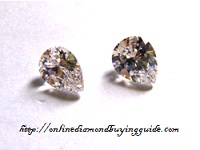
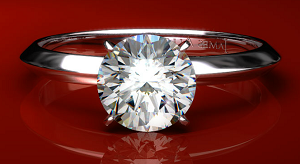
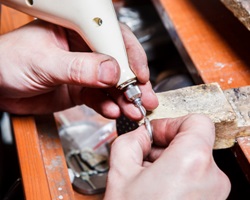
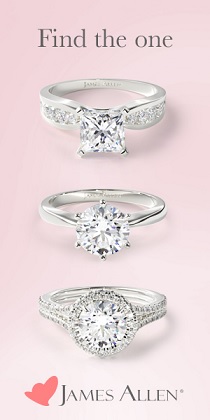









12 Comments
Hello! Not sure if you had replied to my other comment on here since I can’t find my comment. Was just wondering what you think of Vera Wang engagement rings? Excellent website by the way! Thank you! :)
I did reply to that comment about Vera Wang rings. It’s on this page: https://beyond4cs.com/engagement-ring/differences-between-10k-vs-14k-vs-18k-gold/
You will need to scroll all the way down to see it.
Hi Paul,
You seem to provide great, unbiased information on your site so I have a question as someone very new to diamond shopping.
I recently purchased an ideal cut cushion modified brilliant diamond from a trusted online retailer as the center stone of an engagement ring. Long story short my fiancé decided to change the setting to something different a few months afterwards. Upon getting the new final engagement ring we received our new appraisal. This jeweler classified the center stone’s cut at Fair-Good and provided numerous specifications as to why he graded it this way which after I researched seemed to be correct. Is the cut grade on this type of stone subjective? Should I contact the retailer who sold me the diamond and ask about their grading methods? Thanks!
There’s no cut grade on gia reports for fancy shapes. So, take whatever claims your vendor says about the diamond being “ideal” with a pinch of salt. I would use an ASET to determine light performance myself instead of relying on someone else to claim what it is. The only reliable lab that do ray tracing and light analysis for fancy cut diamonds is AGS and it is only for specific shapes like princess, cushion and ovals.
Hello, Paul.
First of all: thank you for your advice and information you wrote. It is really helpful, as many people like me are generally not accustomed to know about diamonds nor rings, and then we need to sudenly spend a good amount of money on them.
I wanted to know if you could please tell me your opinion on this engagement ring for my girfriend. I went to a jewelry and tried to apply what I learnt here (for instance, important of cut):
It is a 14k white gold, round center 3-stone ring mounting with 2 sapphires and a diamond.
-Diamond: .32 CT. Cut: Very good. Color: I. Clarity: VS2.
-Sapphires: Two loose sapphires (no info about them. I know they cost 80 US$ each).
After reducing the price several times (several minutes of tug of war – I am a student, so they tried to help me very kindly): they offered me all of that for 1000 US$. They said it is a very good deal. They were very nice to me and helpful.
I think they graded everything by themselves, so maybe a VG cut might be a Good cut for other people.
Thank you very much!
For small purchases, most diamonds don’t get graded by a 3rd party lab. You can actually size them up and ask them to show you diamonds that are graded by GIA as a triple excellent and compare them against the ring you are interested in. This will give you an idea of what you are buying. Knowing that they are only a “Very Good” cut regardless of who graded the diamonds actually makes me wary. I think it’s going to be a bad deal.
Thank you so much for the informative page! Has helped me educate my self somewhat on picking my perfect ring at Blue Nile.
If you have a minute could you please check these diamonds out and give me your opinion on these. I ideally would like a 1.80 for under 11,500, but don’t think that is going to happen with a great cut. Or if you have any other suggestion I would really appreciate it. Diamond would be on a pave band.
Thank you for your time.
The link doesn’t work for me. Only the person who logged into the BlueNile account can see the diamond comparison. It would be best to copy and paste the direct url links of the diamonds you are looking at or email me in private.
Thanks for the great articles Paul. One question: do you think a recognized cut grading system for fancy cut diamonds will be adopted, at some future date, by the industry? IGI seems to be developing processes to address this segment and market share. Do you have any insights about the reliability of igi cut grade parameters?
There are big strides being made towards that. AGS has led in this area and there are now cut grading systems established for cushions, emeralds and ovals. The thing is, unless the manufacturing sector (i.e. polishers, rough buyers) decide to prioritize cut quality and push for reforms in this aspect, GIA will not be “motivated” enough to develop systems for fancies.
The IGI ideal cut rating and parameters they use to determine that is something I can agree on. In fact, I think they are on a slightly better level than GIA’s Excellent cut rating. However, the problem with IGI is that their color/clarity ratings are usually off by a 1-2 grades and that matters alot in terms of valuation.
Hi Paul,
Thank you for all of the helpful information on your site. I wonder if you have thoughts on what, in your opinion, is the sweet spot for stud earrings. I am looking TCW of about 2.6 – a little over 3. Based on your advice, I’ve looked at I color, SI1. Now for cut.. If I go for the tippy top only hearts/hearts and arrows, prices are pretty high. Do you think I can get away with a lesser cut on earrings? If I go with a lesser cut, do I need to up the color or quality? I’ve found a couple of pairs at Blue Nile that fall within the AGS Ideal but they do not show the crisp arrows seen on a only hearts etc. cut. I do want sparkle!
Thanks for any advice…
–Ros
For earrings, cut quality and size matter the most. By you choosing an I color and SI1 clarity, you have already gone the practical route to save money. The diamonds at Blue Nile generally aren’t well cut even if they fall under “ideal proportions”. You need to shop within their signature Astor collection to get the better cut stones. And cut does matter because it affects sparkle. Don’t scrimp on that.